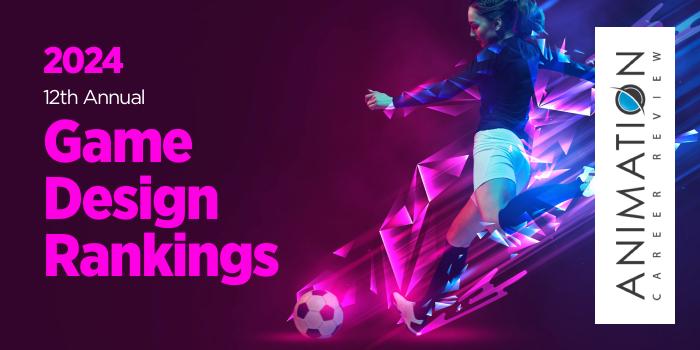
Create your own video games with Unreal Engine or work on the next AAA title! Turn your passion for games into a career with CG Spectrum’s game design, programming and game art courses led by industry pros from major studios. Learn more.

| Ranking | School | City |
|---|---|---|
| 1 | Michigan State University | East Lansing |
| 2 | Ferris State University | Multiple |
| 3 | Eastern Michigan University | Ypsilanti |
| 4 | College for Creative Studies | Detroit |
| 5 | Lawrence Technological University | Southfield |
Our 2024 ranking of the top game design school programs in Michigan. For an explanation of the ranking criteria, click here.

The College of Communication Arts and Sciences (ComArtSci) and the College of Engineering at Michigan State University (MSU) provide several paths to study game design. Serving more than 3,500 students, the ComArtSci houses the Department of Media and Information (MI)—home to the Game Design and Development Program. Established in 2005, the program consists of a Games and Interactive Media BA, a Game Design and Development minor, a Media and Information MA (MI MA), and a Serious Games MA certificate.
The College of Engineering at Michigan State University houses the Department of Computer Science and Engineering—home to the Computer Science (CS) program. Available pathways include the BS, MS, and PhD. All programs allow students to specialize in MI Studies, with the option to take games-related courses in other departments. Students in all programs will also take courses in Systems Design and Analysis; Theory and Algorithms; and Data Analysis and Applications.
The Game Design and Development minor in the College of ComArtSci can also be added any other major at MSU. The program requires 15 credit hours, including courses such as Game Design and Development I and II; Collaborative Design; and Game Design Studio.
The Serious Games MA certificate attracts MSU MI graduate students, CS students, Master of Arts in Educational Technology (MAET) students, and doctoral students from other universities. However, the certificate is open to all MSU graduate students as a stand-alone program. Courses include Theories of Games and Interaction Design; Understanding Users; and Foundations of Serious Games. The Serious Games MA certificate is transcriptable, and it can be completed on campus or online.
The MSU Games and Interactive Media BA is a collaborative, project-based program with three focus areas: Game Design, Games Graphics and Animation, and Game Development. Students in all areas will explore the design process, effects, artistry, management, and production of video games, emerging interactive media, AR/VR, and board games. Examples of required courses include Media and Sketching Graphics; Games and Society; Methods for Understanding Users; Games and Interactivity; and Bringing Media to Market.
Students in the Game Design focus area will take additional courses such as Game Level Design; Building Virtual Worlds; Game Interface Design; Game Design and Development I and II; and Serious Game Design Studio. Course examples for the Games Graphics and Animation area include Advanced 3D Modeling; Compositing and Special Effects; Concept Design for Games, Film, and TV; and Advanced Three-Dimensional Computer Animation.
Game Development students will take courses such as Introduction to Programming I and II; Building Innovative Interfaces; Game and Interactive Media Development; and Matrix Algebra with Computational Applications.
All BA students will have opportunities to work on real-world projects with partners such as Electronic Arts (EA), Blizzard Entertainment, Rockstar Games, Ubisoft, Insomniac Games, and Bungie. Students also have access to the GEL Lab and the Games for Entertainment and Learning Lab. Both provide state-of-the-art technology for designing prototypes, learning new techniques, and to advance research on the individual and social impacts of digital games.
Students will graduate from the MSU Games and Interactive Media program with a professional portfolio of both large and small projects that reflect a wide range of works. Program alumni are prepared to pursue careers such as Game Designer, 2D Artist, Interaction Designer, Game Scenario Writer, Producer, Technical Designer, Usability Engineer, Programmer, UI/UX Designer, Technical Artist, Level Designer, Quality Assurance, and Project Manager.
The Media and Information MA at Michigan State University is a STEM-approved program that explores the design, the use of communication technologies and information, and management. The program is immersive, hands-on, and customizable, with opportunities to engage in real world experiences. As of 2024, MI MA students also have the option to focus in Game Design, HCI/UX, Information Studies, or Media Policy, or customize a track with courses from all focus areas.
In addition to specific focus area courses, all MI MA students will take courses such as Foundations of Serious Games; Game and Project Design Studio I and II; Interaction Design; Interactive Usability and Accessibility: Design and Evaluation; Global Media and Communications; and Theories of Games and Interaction Design.
Other program features include access to state-of-the-art facilities; participation in game development and testing; access to labs that explore virtual reality (VR); and participation in research groups and visiting artist talks.
The culminating experience for the MI MA is the Master’s Project, completed across two courses. Graduates of the MI MA program at Michigan State University are prepared to pursue leadership roles in areas such as 3D Game Design, UI/UX, and 3D Technology. Program alumni have been hired at major studios such as Rockstar Games, EA, Insomniac Games, Blizzard Entertainment, Ubisoft, and Bungie.
Founded in 1855, Michigan State University began as the Agricultural College of the State of Michigan. On the first day of classes on May 14, 1857, the College welcomed five faculty members and 63 students into three buildings: College Hall, Saints’ Rest, and a brick horse barn. When it opened, the school became the first institution of higher learning in the U.S. to teach scientific agriculture.
Today, MSU is one of the nation’s premier land-grant research universities. The school serves approximately 51,315 students enrolled in more than 200 programs across 17 degree-granting colleges. Michigan State University is accredited by the Higher Learning Commission (HLC).

Ferris State University (Ferris State) provides multiple paths to study game design across several colleges and schools. The School of Digital Media in the College of Business has a Digital Animation and Game Design (DAGD) BAS and a Digital Media Software Engineering (DMSE) BS. Kendall College of Art and Design (KCAD) houses a Digital Art and Design BFA.
The Digital Animation and Game Design BAS explores games, animation, programming, digital effects, and emerging technologies. Students in this program may specialize in Game Development or 3D Animation. Course examples include Game Programming 1-2; Multiplayer Game Program; Interaction Design; Digital FX; Multimedia 1-2; Animation Techniques; Level Design; and Special Topics in DAGD. All students will complete a professional internship, project, and portfolio to graduate.
The Digital Media Software Engineering BS at Ferris State University requires 125-126 credit hours of study. Twelve hours are dedicated to Application Domain Electives provided in four-course sequences. The Game Design and Development sequence consists of Game Programming 1-2; 3D Modeling and Animation OR Introduction to Game Design and Development; and Level Design. The DMSE BS also consists of coursework in engineering fundamentals, mathematics, business and management, and professional development
During the final year of the program, Ferris DMSE BS students will complete the mandatory Software Development Industry Certification, Capstone in Software Engineering, and Software Engineering Applied Internship. These required courses are part of the professional development component of the program.
The KCAD Digital Art and Design BFA is a flexible 120 credit hour degree program that allows students to specialize in a number of areas. This allows students to develop portfolios in media markets such as 3D Game Art; Visual Development; Interaction Design; 2D Animation or Motion Design.
All students will complete supportive studio courses (24 credit hours); major studio courses (42 credit hours); art history (12 credit hours); and general education (30 credit hours). Students will complete the remaining credits in one of three pathways including Narrative Studies, Cultural Studies, or Philosophical Studies.
Course examples for the Digital Art and Design BFA include Digital Imaging; Digital Character Drawing; Animation Processes; Concept and Production Art; 2D Character Design; 3D Motion Design; Storyboard Art; 3D Game Art I-II; Interaction Design; Professional Studio I-II; 2D Character Animation; and Video. The program culminates with a professional portfolio of the students best work in their focus area.
Graduates of the games-related programs at Ferris State University may pursue careers in many traditional and growing industries. Examples include Video Game Development, Medical Applications, Software Product Design, 2D and 3D Animation, Advertising Design, User Experience Design, Aerospace, Mobile Application Development, Sound Design, Educational Application Developer, Storyboard Art, Motion Design, 3D Game Art, Visual Development for Games and Animation, and Background Design.
Ferris State alumni work at companies such as Epic Games, Disney Television Animation, R/GA, YouTube, and Idol Minds Game Development.
Ferris State University was established in 1884. Located in Big Rapids, Michigan, the school serves more than 10,000 students enrolled in more than 190 programs across seven degree-granting colleges. Ferris State university is accredited by the Higher Learning Commission (HLC).
Founded in 1928, Kendall College of Art and Design is one of the seven colleges within Ferris State University. Located in downtown Grand Rapids, Michigan, KCAD serves 565 students enrolled in dozens of specialized undergraduate degree programs and several graduate and certificate programs. As part of Ferris State University, Kendall College of Art and Design is accredited by the HLC. KCAD is also an accredited institutional member of the National Association of Schools of Art and Design (NASAD).

The College of Arts & Sciences at Eastern Michigan University (EMU) is home to the School of Art & Design. Accredited by the National Association of Schools of Art and Design (NASAD), the school provides more than a dozen programs, including a STEM-designated BS in Simulation, Animation and Gaming (SAG) and a SAG minor. Course examples for the 21 credit hour minor include Introduction to Game Design; Graphics for Simulation I-II; Environment Design; and Web Publishing Technology.
With approximately 138 students enrolled, the multidisciplinary SAG BS combines traditional art, story development, and creative writing, with coursework in animation, rigging, lighting, camera work in 3D, and modeling. The program requires a minimum of 120 credits, with 81 credits in the major.
Course examples include Introduction to Game Design; Texturing and Mapping; Introduction to Unity I-II; Story Development; Simulation and Animation Dynamics; SAG Movement; Advanced Principles of Animation; Vector Illustration for SAG; Organic Rigging, Introduction to Simulation, Animation and Gaming; and Animation Studio.
The culminating experience for the BS program is the Senior Projects in SAG course. Students will apply the simulation, animation, and gaming techniques they have learned to complete a team based final project. This three-credit course also covers the necessary skills for career success. Guest speakers and site visitations are also part of the course.
Graduates of the SAG programs at Eastern Michigan University are prepared to pursue a variety of roles in the industry such as Game Designer, Game Artist, Game Developer, Game Programmer, Special Effects Artist, Character Designer, Game Animator, Concept Artist, Modeler, Graphic Designer, and Storyboard Artist.
Founded in 1849, Eastern Michigan University is the state’s second oldest public university. The school serves approximately 13,350 students enrolled in around 200 undergraduate majors and 150 graduate programs across five colleges, the Graduate School, and the Honors College. Eastern Michigan University is accredited by the Higher Learning Commission (HLC).

The College for Creative Studies (CCS) houses the Entertainment Arts (EA) Department, which provides a STEM-designated BFA with a Game Design major. All first-year students, regardless of major, will take courses in the Foundation Department. Areas explored include drawing, color theory, and basic design.
EA Game Design students will complete a total of 126-127 credits that explore environment design for game, animation, and film; traditional drawing and CGI tools; immersive gameplay; 2D and 3D; augmented and virtual reality (AR/VR); and mobile platforms. All students benefit from sponsored projects with major companies and studios such as Epic Games, GM, and Unity 3D.
Other program benefits include access to state-of the art labs and equipment such as the Gaming Lab, AR/VR Lab, software and hardware, and editing suites; small class sizes; internship opportunities; and courses taught by industry professionals. Course examples for the program include Advanced Computer Generated Environments; History of Video Games; Game Projects I-II; Game Ideation; Modeling and Texturing; Digital Techniques; Process and Making; Game Trend; and Game Professional Futures.
The culminating experience for the EA Game Design program is Game Senior Studio, completed across two courses totaling six credit hours. Graduates are prepared to pursue roles such as Character Artist, Game Designer, VFX Artist, AR/VR Developer, Environment Designer, Technical Artist, and Vehicle Designer. EA Game Design alumni have created game environments for World of Warcraft at Blizzard Entertainment; they have worked on more than 15 Marvel movies; and they designed one third of the six Batmobiles.
CCS Game Design graduates have also landed positions at Nickelodeon, Epic Games, Disney Animation Studios, Paramount, Disney Television Animation, Pixomondo, Turn 10 Studios, Outloud Media, Wedoo, Certain Affinity, General Motors, Funcom, ustwo Games, and Monomi Park.
College for Creative Studies was founded in 1906 as the Detroit Society of Arts and Crafts. This private, nonprofit college serves more than 1,400 students enrolled 12 majors leading to a BFA, four programs leading to an MFA, and one program leading to an MA. College for Creative Studies is accredited by the Higher Learning Commission (HLC). The school is also an accredited institutional member of the National Association of Schools of Art and Design (NASAD).

Lawrence Technological University (LTU) provides paths to study games in the College of Architecture and Design (CoAD)/Department of Design, and the College of Arts + Sciences/Department of Math and Computer Science. The CoAD/Department of Design has a Game Design program with options leading to a BFA or a minor. The Department of Math and Computer Science has a Game Software Development Certificate, and a Computer Science BS with a Game Software Development concentration.
The Game Design BFA is a multidisciplinary, project-focused program has three optional concentration options: Digital Environments, Digital Interface, and Digital Objects. All concentration areas in this 120 credit hour program explore game assembly, level design, and system design. In addition to taking several game studios throughout the program, students may participate in the Game Design Unreal Incubator/CoAD.
This intensive, full-immersion development program allows Game Design BFA students to develop and publish an Unreal Engine-powered digital interactive experience. Guided by professional designers in the industry, students will gain will first-hand experience working through the game development pipeline. The program culminates with the release of a commercial digital game. Game Design BFA students also have the opportunity to complete an internship.
The LSU BS in Computer Science with a concentration in Game Software Development requires 129 credit hours of study. In addition to several integrated game studios, an internship, and the Senior Capstone, BS students will complete courses such as Game Design; University Physics Lab; Game Design and Animation; Computer Graphics Programming; Artificial Intelligence (AI); Software Engineering; and Operating Systems.
The certificate in Game Software Development consists of 13 credit hours. Required courses include Introduction to Computer Games and Animation; Game Genre Development; Game Design; and Computer Science 1. Students will work in interdisciplinary teams to create original games.
All LTU Game Design and Computer Science students have opportunities for professional networking such as school trips, expos, and meetups. Graduates are prepared to pursue positions in fields such as game design and development, game writing, 3D modeling, game programming, software development, app development, art direction, and user experience and user interface design (UX/UI).
LTU Games alumni have been recruited by companies and studios such as Jackbox Games, Ford, Dead Art Games, Flyover Games, Fiat Chrysler Automobiles, Seventy 7, Dreaming Door Studios, FanLabel, Chimera Labs, Pluto, Pixo, and Mackevision.
Founded in 1932, Lawrence Technological University focuses on STEM and Design education through more than 100 degree programs across four colleges. Serving nearly 3,000 students, LTU has additional learning centers in southeastern and northern Michigan, Canada, China, Germany, India, Mexico, and Taiwan. Lawrence Technological University is accredited by the Higher Learning Commission (HLC).